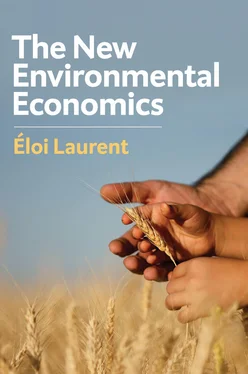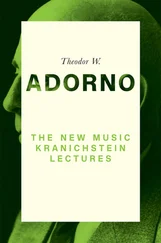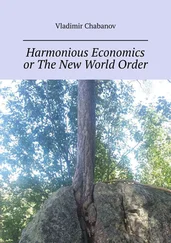In such a game, the logic of individual interest and uncertainty about the cooperative ability of other players should induce individuals not to cooperate, that is never to contribute to the common account. Reality is strikingly different: Players start by investing on average half of their endowment on the common account. The willingness to cooperate is thus much stronger than expected, especially if players are given the means to punish the non-cooperators (for instance through financial fines imposed on those who never contribute to the common account).
Ostrom will go on to verify this theoretical intuition throughout the world and will make an even bigger discovery: In hundreds of meticulously documented cases, humans are able to avoid the “tragedy of the commons” by building collective rules whose pillars are reciprocity and trust. The “public good” is no longer an abstract common account, but, very concretely, rivers that should be preserved from pollution, forests that must be reasonably exploited, fish that must be harvested with moderation to allow them to reproduce. From Swiss forests to Japanese pastures, irrigation systems in Spain to irrigation systems in Nepal, Ostrom shows that humans are able to cooperate for preserve, conserve, and prosper.
From her field observations, Ostrom will draw core principles for a sustainable management of common resources. These principles, eleven of them, can be simply understood as the rules of the game of human environmental cooperation (see Box 3.2).
Box 3.2the rules of the game of environmental cooperation
1A. User boundaries: Clear and locally understood boundaries between legitimate users and nonusers are present.
1B. Resource boundaries: Clear boundaries that separate a specific common-pool resource from a larger social-ecological system are present.
2A. Congruence with local conditions: Appropriation and provision rules are congruent with local social and environmental conditions.
2B. Appropriation and provision: Appropriation rules are congruent with provision rules; the distribution of costs is proportional to the distribution of benefits.
3. Collective choice arrangements: Most individuals affected by a resource regime are authorized to participate in making and modifying its rules.
4A. Monitoring users: Individuals who are accountable to or are the users monitor the appropriation and provision levels of the users.
4B. Monitoring the resource: Individuals who are accountable to or are the users monitor the condition of the resource.
5. Graduated sanctions: Sanctions for rule violations start very low but become stronger if a user repeatedly violates a rule.
6. Conflict resolution mechanisms: Rapid, low cost, local arenas exist for resolving conflicts among users or with officials.
7. Minimal recognition of rights: The rights of local users to make their own rules are recognized by the government.
8. Nested enterprises: When a common-pool resource is closely connected to a larger social-ecological system, governance activities are organized in multiple nested layers.
Source: Elinor Ostrom “Beyond markets and states: Polycentric governance of complex economic systems,” Prize Lecture, 2009 ©The Nobel Foundation
These principles have emerged from the communities studied themselves. By contrast, rules imposed by authority upon local groups by distant governments often are counterproductive because the authorities in question do not have sufficient information or legitimacy (the privatization of natural resources also suffer from many limitations, to begin with their injustice).
In the Ostromian framework of analysis, we clearly see the importance of the relationship – fundamental, but often neglected – between resources and trust, or natural and social capital. Economist Partha Dasgupta has also insisted on the importance of institutional trust in the management of natural resources exploited in common. In environmental governance systems, it is critical that participants are properly informed on future gains from social cooperation. 15Mechanisms of trust and mistrust are also at the heart of international environmental governance, starting with climate negotiations (see on this point, Finus 2008). 16The governance of the commons can be sustainable only if it acknowledges distributional issues and justice principles. We now turn to their study.
1 Nash (1972). 2 Worster (1979). 3 Cronon (1992). 4 Cronon (1991). 5 Muir (1938). 6 The Roosevelt Arch has become the formal North Entrance to Yellowstone National Park at Gardiner, Montana. 7 The motto of the National Trust is “For ever, for everyone.” It takes care of 778 miles of coastline and over 248,000 hectares of land which are inalienable (they cannot be sold or developed against the wishes of the Trust without the consent of Parliament). 8 “… we sow cereals and plant trees; we irrigate our lands to fertilize them. We fortify river-banks, and straighten or divert the courses of rivers. In short, by the work of our hands we strive to create a sort of second nature within the world of nature.” Cicero, De Natura Deorum (The Nature of the Gods, c. 45 BC). 9 Mumford (1931).10 Pinchot (1909).11 Hard or strong sustainability implies that renewable resources must not be drawn down faster than they can be renewed – i.e. that (critical) natural capital must not be spent: We must live off the income produced by the capital. Soft or weak sustainability accepts that certain resources can be depleted as long as they can be substituted by others over time. Natural capital can be used up as long as it is converted into manufactured capital of equal value.12 After a heated public argument between Muir and Pinchot among others, the City of San Francisco was authorized by the US Congress to build a dam and reservoir in Hetch Hetchy Valley in 1913.13 “Every individual … neither intends to promote the public interest, nor knows how much he is promoting it … he intends only his own security; and by directing that industry in such a manner as its produce may be of the greatest value, he intends only his own gain, and he is in this, as in many other cases, led by an invisible hand to promote an end which was no part of his intention.” Adam Smith, The Wealth Of Nations, Book IV, Chapter II, p. 456, para. 9.14 Ostrom (1990).15 See for instance Dasgupta (2005).16 Finus (2008).
Конец ознакомительного фрагмента.
Текст предоставлен ООО «ЛитРес».
Прочитайте эту книгу целиком, на ЛитРес.
Безопасно оплатить книгу можно банковской картой Visa, MasterCard, Maestro, со счета мобильного телефона, с платежного терминала, в салоне МТС или Связной, через PayPal, WebMoney, Яндекс.Деньги, QIWI Кошелек, бонусными картами или другим удобным Вам способом.












